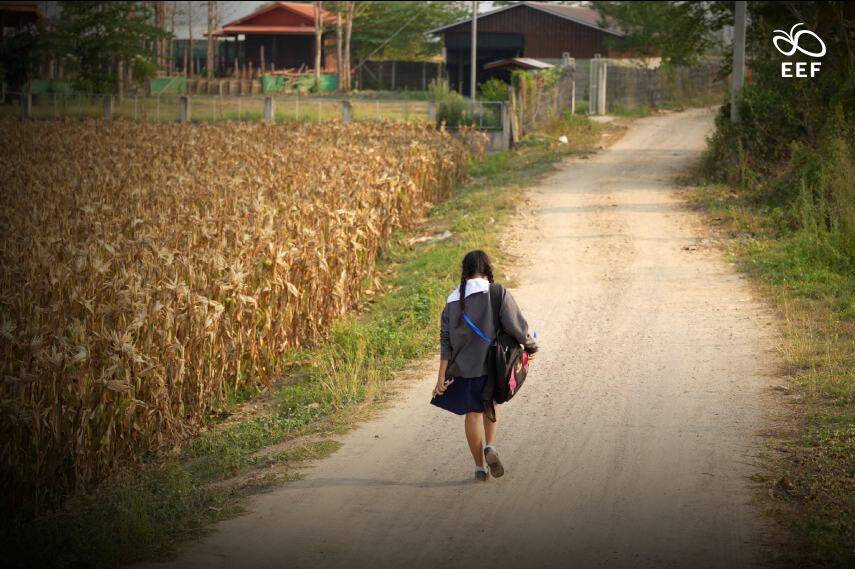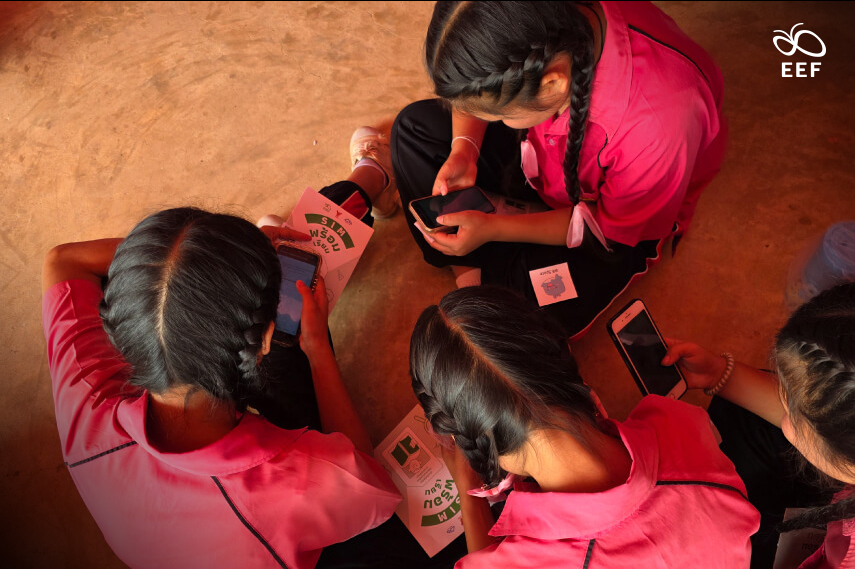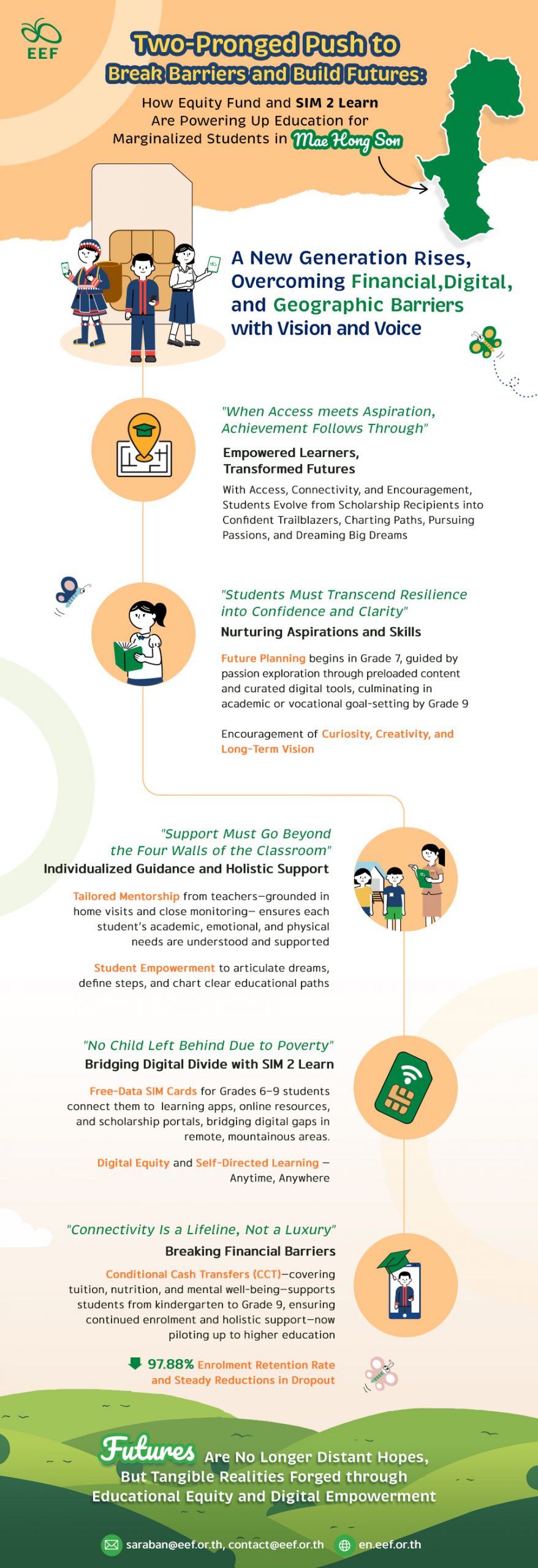
In the remote mountain borderlands of Mae Hong Son, Ban Huai Singh School in Mae Yuam Subdistrict stands as a vital sanctuary for children from distant highland villages, where rugged terrain makes access to education a formidable challenge. More than half of its 304 students—from kindergarten through Grade 9—live on campus, transforming the school into not just a place of learning but a lifeline. Here, two transformative initiatives spearheaded by the Equitable Education Fund (EEF) Thailand converge: Equity Fund and SIM 2 Learn, a strategic, two-pronged push that breaks barriers and builds futures. Through the Conditional Cash Transfer program, over 210 students receive crucial financial support that alleviates economic hardship and keeps them enrolled. Simultaneously, free-data SIM cards extend internet connectivity to the most isolated learners, empowering independent study and connection beyond physical confines. Together, these initiatives do more than fill classrooms; they ignite potential and equip a generation with the tools to thrive.

“Most of our students hail from remote hill villages or border areas where schooling ends at the primary level,” explained Sombat Yawichai, Principal of Ban Huai Singh School. “To continue their education, they must journey far, making our school their new home.” Far beyond an opportunity expansion school, Ban Huai Singh School embodies hope for families grappling with poverty, who seek uninterrupted education for their children. Harder still is the transition to a strange environment, stripped of familiar support, compounding existing disadvantages such as scarce resources and limited learning assistance. It is precisely here that the Equity Fund scholarship opens doors, with its impact evident in steadily declining dropout rates and rising advancement to higher grades. This targeted support effectively narrows the educational gap, turning vulnerability into resilience.
At the heart of Ban Huai Singh School’s mission is fostering student self-awareness and ambition from Grade 7 onwards. By Grade 9, students are guided to identify their aspirations, fields of interest, and the steps necessary to achieve them, an essential process for reducing dropout risk. The Equity Fund Scholarship offers holistic support that extends beyond tuition, encompassing academics, attendance, nutrition, growth, and mental well-being, ensuring a stable foundation for success. Through regular home visits, the school gains insight into each student’s unique circumstances, acknowledging the profound difficulty of simply attending school. Continuous communication with primary teachers ensures seamless educational support, reflecting a system committed to student retention and growth. As Principal Sombat emphasizes, “Before graduating Grade 9, children must understand their interests, know their options, recognize available pathways, and envision their ultimate destination. Armed with this clarity and resources, their chances of success rise markedly.”
Yet, the Equity Fund Scholarship is no mere financial grant; it is the cornerstone of the EEF’s Education Security System—an unwavering commitment spanning a 20-year educational journey. In the 2024 academic year alone, the initiative supported 1.3 million students from the Very Poor group, rigorously monitoring attendance, growth, and retention. With a 97.88% enrolment retention rate in the first semester and increasing progression to higher education, the EEF’s conditional cash grants are transforming educational opportunity into sustained achievement. Once confined to kindergarten through lower secondary levels, the initiative has now extended its reach by piloting support for upper secondary students in Border Patrol Police schools and select higher education fields, thereby reinforcing its commitment to closing dropout gaps and broadening educational horizons.

Crucially, lifting financial barriers is only half the equation. To bridge the digital divide, the EEF, in partnership with the National Broadcasting and Telecommunications Commission (NBTC) and Infinite Sim, launched the SIM 2 Learn initiative, providing free internet access to scholarship students in Grades 6 to 9 from February to July 2025. For children living hundreds or even thousands of kilometers from urban centers, this connectivity fosters self-directed learning and intellectual curiosity, essential foundations for academic success in the digital age.
This is particularly evident at Ban Huai Singh School, where many students live on campus due to distance, and the initiative has become a vital tool in overcoming device shortages and unstable networks. By enabling equitable access to digital resources that support both academic and vocational learning, SIM 2 Learn empowers teachers to move beyond content delivery and take on mentoring roles, guiding students as they explore personal interests, expand aspirations, and shape their own educational paths.
Echoing Principal Sombat’s conviction that digital exclusion poses a greater disadvantage than geographic isolation, computer teacher Apichet Muenthaep champions the integration of technology despite persistent infrastructural challenges. At his school, ambitious students with interests ranging from dance to cooking once struggled to pursue their passions due to poor connectivity and limited access to devices. In response, teachers curated online content to spark curiosity and preloaded materials to bypass unstable networks. Since the launch of SIM 2 Learn, students have become more autonomous, actively seeking knowledge beyond school hours.
Building on this momentum, Apichet highlights how visual learning accelerates comprehension—especially for Grade 9 students accessing quality resources for scholarships, jobs, and exams—and calls for the initiative’s year-round expansion through education-specific SIMs enriched with career guidance, scholarship details, and mental health support. “If we truly want to support remote children, affordable, reliable internet must be recognized as fundamental infrastructure,” he insists. “Free or affordable connectivity doesn’t just help; it transforms learning opportunities, expanding them one hundred percent.”
For Ban Huai Singh’s students, the SIM 2 Learn initiative has unlocked doors to knowledge, confidence, and possibility. Anchalee Wimansakorn and Tattithat Nitiphuttikhachon, once limited by unstable school Wi-Fi, now enjoy the freedom to learn anywhere. “I can research study paths and plan my future with confidence,” Wimansakorn reflects. Nitiphuttikhachon echoes this liberation: “Exploring beyond lessons and using the Findstudentship website to seek further scholarship opportunities feels like having a roadmap for my education.” For Chompoonut Wanajaroenyod and Wannasa Chaimanokul, the SIM eased financial strain and promoted academic equity. Wanajaroenyod, who previously relied on her parents for monthly top-ups, now saves for entrance exams and “with all the learning apps included, we finally have a fair chance to keep up with students from other areas.” Chaimanokul hopes the program extends year-round, calling it “a game changer for many of us.” Meanwhile, Kittiphat Nateethongden harnesses the internet to fuel his passion for language learning, confident that “others deserve the same chance.”

Together, Equity Fund and SIM 2 Learn form a cohesive, future-facing framework that dismantles the trio of financial, digital, and geographic barriers obstructing equitable education. Their synergy ensures that marginalized students are not only able to remain in school but are also equipped with the tools, connectivity, and confidence to flourish far beyond the classroom. By synchronizing sustained economic support with digital inclusion and personalized guidance, the EEF’s two-pronged strategy transforms education from a distant hope into a tangible, lived reality. In doing so, it empowers students in remote corners like Mae Hong Son to dream their dreams, pursue their passions, and chart their own paths, proving that when access meets aspiration, even the most entrenched obstacles can give way to extraordinary achievement.
All For Education is all about people; only when all is in for education is Education For All. Join the movement to reduce educational inequality. Support the EEF by donating to fund research, partnerships, and assistance for children, youth, and adults in need of educational support. Click the link to contribute today and help create a society where education is open and equal for all. Together, we can make a lasting impact.
Source:

